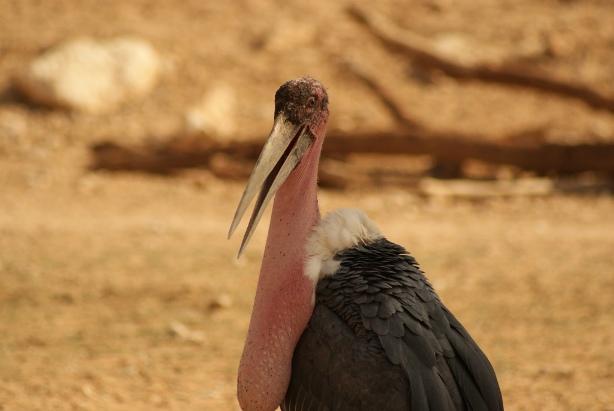Pollution problem in Uganda leads to explosion in scavenger stork population
The Maribou stork is not the most attractive bird. It’s featherless head helps ensure it scavenge food. (Photo by Balaji via Wikimedia Commons.)
The Marabou stork population in Uganda is exploding.
Uncollected garbage and slaughterhouse remains are just two food sources that have suddenly become more plentiful, meaning the storks are moving in and setting up camp.
Even from a distance, they’re huge. Wingspans of up to 9 or 10 feet. They’re dark and graceful. But up close, they’re not so cute. One scientist described them as looking like a dirty old man.
The storks are bald. The head and neck are pinkish without feathers. Long pouches droop beneath their necks like fleshy tube socks. A bright red bump swells from the nape. The rest of the bird is covered in black and white feathers.
Physical appearances aside, this portrait of Marabou family dynamics might seem rather lovely. The birds pair off once and stay together for life. When a chick hatches, mom and dad take turns watching after and feeding the little birds.
But feeding, that’s where the problems begin. These storks are scavengers. Willing to eat just about anything in sight. In the wild, the storks gobble up carcass scraps, and feces. That’s why they’re bald — otherwise the head feathers would get clotted up with blood and grime.
For storks, the big cities of Uganda are a veritable buffet.
“Mainly what attracts them is garbage. In Africa, garbage collection is not good so the garbage stays lying around,” said Lilian Twanza, a graduate student at Makerere University, in the city of Kampala.
Complicating matters, the stork droppings are acidic. When they settle into a tree or on a power pole, those droppings fly.
“If you keep leaving your car under the shade, wanting protect it from the sun, the Marabous will spoil it,” Twanza said. “And then when people are passing, it can drop on you also – on your clothes, in your hair.”
The droppings corrode rooftops and trees. The birds even end up targeting themselves — their legs aren’t typically white, unless they’re coated with their own droppings.
Twanza says that Ugandans are beyond frustrated with these storks and have taken matters into their own hands.
On one recent Monday, a tree was felled and the baby storks in the tree were left on the ground to die. Twanza says they typically come up with a reason for removing the tree, but reality is just that they want the storks gone.
“Usually they use another excuse so that the environment people don’t come, complaining a lot,” Twanza said. “They say, ‘We cut the branches because of the electric wires.'”
When the babies fall to the ground, the parents move on. It doesn’t fix the problem, though. The following year, the Marabou pair will breed again and hatch another two or three chicks.
“The only recommendation is getting rid of garbage,” Twanza said.
Less food means fewer young survive. Gradually, the Marabou numbers will decline. Twanza’s seen it happen on campus. When she first started studying Marabou storks in 2008, she counted 5000 storks filling up the trees and rooftops of the university.
Now, after a few years of improved, daily, trash collection, the numbers are down to 2000.
But Twanza isn’t expecting similar improvements in sanitation throughout Kampala. And yet, at the same time, she recognizes that the birds are important, and even good for Uganda.
“They get rid of everything we don’t want. We want them alive – they are part of the ecosystem,” Twanza said.
